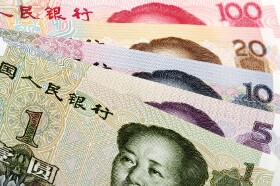The Chinese yuan is trading relatively flat against a myriad of currency rivals midweek as the nationâs virus outbreak has triggered economic growth concerns. After last weekâs better-than-expected gross domestic product (GDP) figures and the International Monetary Fund (IMF)âs optimistic forecast, the spread of the Wuhan coronavirus could throw a wrench into the countryâs plans to rebound from its slump.
On Monday, the IMF revised its GDP forecast for China from 5.8% in October to 6%. The institution cited global economic growth potentially âbottoming outâ and the worldâs two largest economies signing phase one of their comprehensive trade agreement.
Overall, the IMF anticipates that global growth will reach 3.3% this year, up from the 2.9% expansion in 2019. But this figure is below its initial prediction of 3.4% in October.
Last week, China confirmed that its economy grew 6.1% in 2019, the lowest growth rate since 1990. However, economic growth did beat market expectations of 5.9%. Beijing did experience a rebound in industrial output, capacity utilization, retail sales, and fixed-asset investment.
But hopes of a reversal this year might be dashed as China contends with a virus outbreak that is gradually spreading throughout the country and the rest of the world. Chinese authorities confirmed on Wednesday that the coronavirus has killed 17 people so far and there have been 440 confirmed cases. The government noted that it is ramping up efforts to contain an outbreak, but global investors fear that it might limit economic growth initiatives and limit demand for a wide variety of goods and services.
Christopher Balding of the Nikkei Asian Review is not as bullish as others, even without the virus. He writes:
While real estate sector credit, and consequently building, are booming, potentially storing up problems for later, there is little evidence of robust growth in the manufacturing and industrial sectors. In 2019, clothes output was down 6%, metal-cutting machine tools 19%, power generation equipment 15% and packaging equipment off 5%. These do not speak to a robustly healthy economy, rather of excess capacity and years of overinvestment.
This broader weakness is trickling down to the consumer and services sectors. Smartphone and automobile sales are both down about 8%; monthly active users on food delivery apps were down more than 10% in December 2019 compared with a year earlier.
On the data front, foreign direct investment (GDI) into China advanced 5.8% year-on-year to $136.71 billion, a two-year high. The nationâs outbound direct investment tumbled 6% to $110,6 billion. Later this week, the manufacturing and non-manufacturing purchasing managersâ index (PMI) will be released.
The USD/CNY currency pair edged up 0.01% to 6.9068, from an opening of 6.9059, at 15:43 GMT on Wednesday. The EUR/CNY slipped 0.05% to 7.6572, from an opening of 7.6611.
If you have any questions, comments, or opinions regarding the Chinese Yuan, feel free to post them using the commentary form below.
